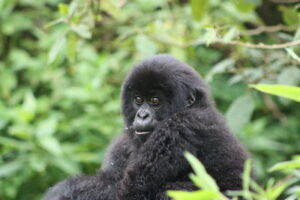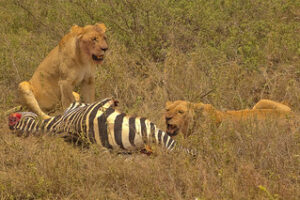Uganda and Rwanda provide different but equally fascinating chances for visiting gorillas. Rwanda ‘s simple access to gorilla trekking inside Volcanoes National Park and developed tourism sector are well-known. Volcanoes National Park Two hours’ journey from Kigali Capital City. On the other hand, Uganda presents a more varied safari experience with two national parks. Mgahinga Gorilla National Park and Bwindi Impenetrable National Park where over 50% of world gorilla populations is found. Every country has different advantages; so, the choice between Rwanda and Uganda boils down to personal taste and special interests.
Overview of the Gorilla Trekking in Rwanda
Rwanda is well-known for its orderly and highly controlled gorilla trekking operations mostly in Volcanoes National Park. For low-budget tourists, this park in the Virunga Mountains near Uganda’s borders from Kigali capital city is easily reachable and a reasonable choice. Rwanda’s commitment to gorilla preservation and sustainable tourism is amply demonstrated by programs involving community involvement and strict laws limiting daily visitor count to 8 people. To limit unnecessary noise, it also caps the minimum age of a visitor at 15 years.
Transportation and accessibility in logistics
Gorilla trekking in Rwanda has one main advantage: it is close to Kigali. The road ride from the capital to Volcanoes National Park takes about 2 hours. That is not the case for the 7-hour Uganda tour that will get one to the southern west part of the country (Kisoro area home of gorilla National Parks) near Rwanda – Congo borders. This accessibility allows visitors to easily combine gorilla trekking with other activities or attractions in Rwanda, like cultural tours and excursions to other national parks like Akagera or private tour of Kigali city, therefore reducing travel time and transportation costs while maximizing your enjoyment.
Nature and Sustainability of gorilla trekking
Rwanda has made tremendous strides in gorilla preservation; evidence of this may be seen in its interactions with surrounding populations and increase of gorilla permit costs to 1,500 USD in Volcanoes National Park. The money earned from gorilla permits directly benefits the local population and supports environmental programs, therefore fostering a sustainable kind of ecotourism.
Travel Experience & Policies for Visitors
Tight monitoring of Rwanda’s gorilla trekking experience helps to minimize disturbance of the gorillas and their habitat. Monitoring a specific gorilla family daily limits one party of up to eight guests. Only one hour with gorillas under licensed guides and trackers is allowed. This controlled technique ensures that gorillas are not under much stress and promises a more personal and less crammed experience, therefore boosting the quality of wildlife interactions.
Cultural and Extra Interests
Apart from gorilla walking, Rwanda offers possibilities to explore its rich cultural past with trips to cultural communities, memorials for genocide, and vibrant markets in Kigali. Including this with your gorilla tour will provide lifetime memories.
Overview of Gorilla Trekking in Uganda
Uganda has a selection of events for individuals interested in gorilla trekking with two national parks: Bwindi Impenetrable National Park and Mgahinga Gorilla National Park. Also, more than half of the gorilla count worldwide are within Uganda. Unlike Rwanda, Uganda’s gorilla trekking adventures usually fit a bigger safari schedule featuring a variety of wildlife, scenery, bird watching, and cultural interactions all around your path.
Variety in Gorilla Trekking National Parks
Uganda’s gorilla trekking experiences are found at Mgahinga Gorilla National Park and Bwindi Impenetrable National Park. Their southwest location near the Congo’s borders marks the edge of the country Renowned for its diversity, Uganda boasts more than half of the remaining mountain gorilla population and offers various hiking routes and gorilla families to visit. Mgahinga also boasts the vulnerable golden monkey as well as more than 110 bird species.
Safari and Variations in Natural Habitats
Apart from gorilla walking, Uganda presents a great range of wildlife and landscapes accessible through safaris. Ten National Parks, including Queen Elizabeth, Murchison Falls, Kidepo Valley, provide opportunities to witness wild animals including African Big Five of lions, elephants, rhinoceros, leopard, Buffalo and numerous bird species, therefore delivering a whole safari experience.
observing culture diversity
Uganda’s cultural diversity is another draw; there are opportunities to connect with locals, see a UNESCO world heritage site kasubi tombs, tour local communities, and witness activities including Kiganda dance. You will also be able to learn about Uganda’s numerous ethnic groups including Batwa, Batooro, and their customs.
Infrastructure and Accessibility
Usually requiring longer journey times of around seven hours and potentially less developed road infrastructure, Uganda’s gorilla trekking areas can be more difficult to access than those of Rwanda. Though, this offers a more adventurous and off-the-beaten-path experience for people seeking a closer immersion into Uganda’s natural and cultural surroundings.
Conclusion for Uganda Vs Rwanda gorilla trekking
In the end, Rwanda and Uganda each offer unique and intriguing gorilla trekking possibilities depending on accessibility, cost, conservation projects, and general tourism infrastructure. Ultimately, the choice between Rwanda and Uganda boils down to personal preferences, budgetary limitations, and the intended scope of the travel experience, thereby allowing every visitor to find an incredible gorilla trekking journey appropriate for their aims and means.




